Diurnal Heating
Diurnal heating is the temperature change over 24 hours. When sunlight shines on the ground, it warms. How much depends on many of the factors introduced in the Energy section. But two factors provide the added energy to warm the area, and they deal with the Sun’s illumination:
-
- The intensity of sunlight illuminating a unit area of ground (beam concentration) and
- The duration of sunlight during the day (declination circles).
An area that experiences a prolonged period of darkness yet a Sun high in the sky by local noon tends to have more substantial diurnal temperature change compared to an area with short periods of light, the Sun remaining low in the sky when above the horizon, or little change in the angle of the Sun above the horizon during daylight.
Large or Small Diurnal Temperature Change?
Examine the following declination circles from Earth and decide if there are the ingredients to make a large temperature change during the next 24 hours or not.
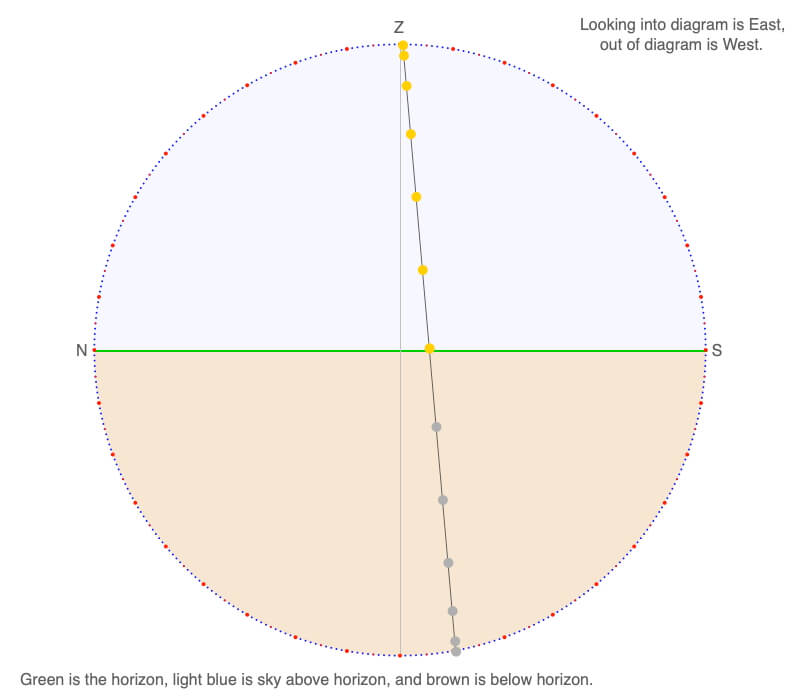
Ingredients for Large or Small Diurnal Temperature Change?
The Sun is nearly directly overhead at local noon, so the beam concentration is very close to 1, which means that there is the most intense sunlight per unit area of ground.
There is close to 12 hours of sunlight for heating and 12 hours of darkness for cooling.
This day and location have the ingredients for a substantial diurnal temperature change.
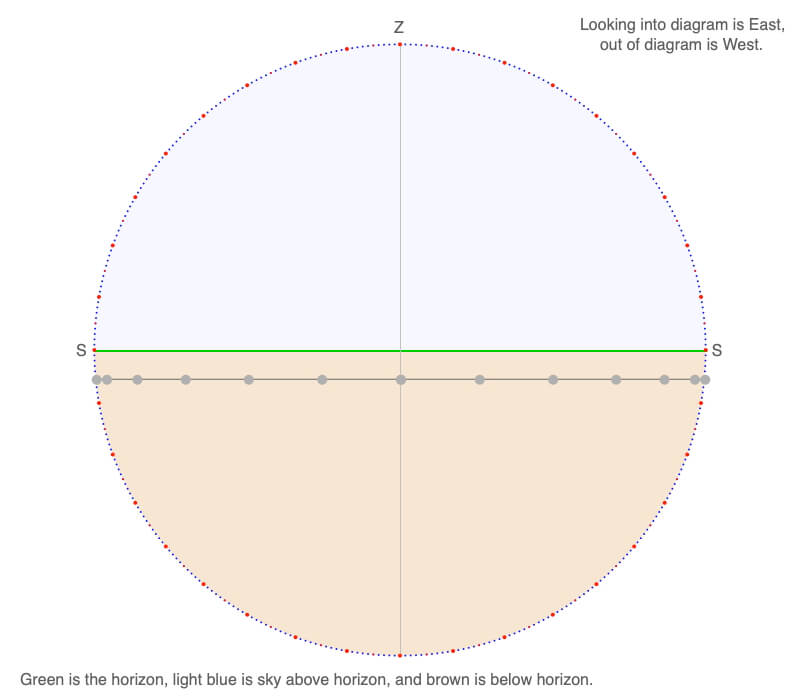
Ingredients for Large or Small Diurnal Temperature Change?
The Sun is below the horizon for the complete 24 hours, so there is no heating! All that may happen is cooling. As an object cools, it emits less and less thermal radiation, so the rate of cooling decreases over time.
This day and location have the ingredients for minimal diurnal temperature change.
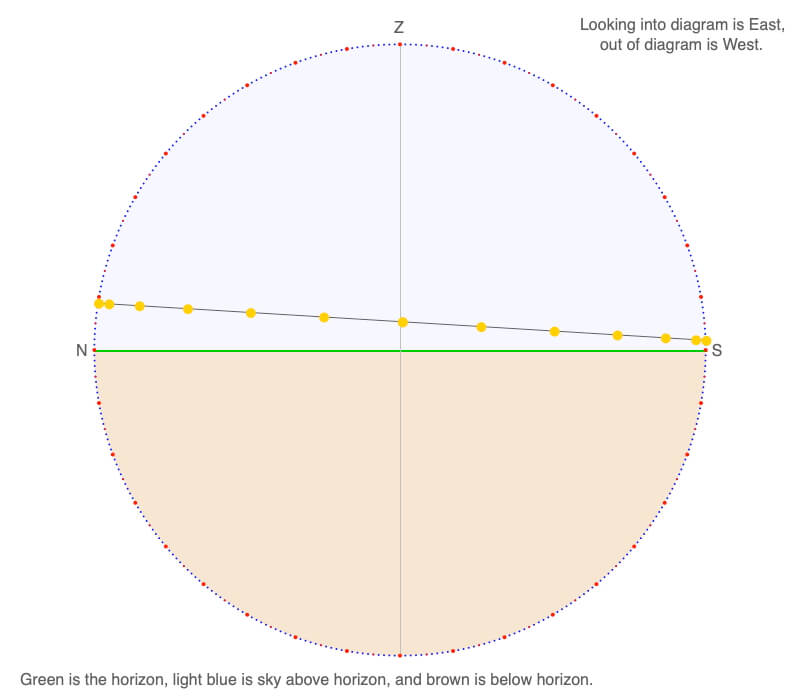
Ingredients for Large or Small Diurnal Temperature Change?
The Sun is above the horizon for the complete 24 hours, so there is sunlight reaching the ground all day. But the Sun stays relatively low in the sky all day (it is less than 10º above the horizon all day). Thee may not be enough sunlight to heat the ground throughout the day, but it will slow any cooling that takes place.
This day and location have the ingredients for minimal diurnal temperature change.
What If You Are Visiting Another Planet?
Examine the following declination circles from a different planet and decide if there are the ingredients to make a large temperature change during the next 24 hours or not. You may need to do this when you are an astronaut visiting exoplanets!
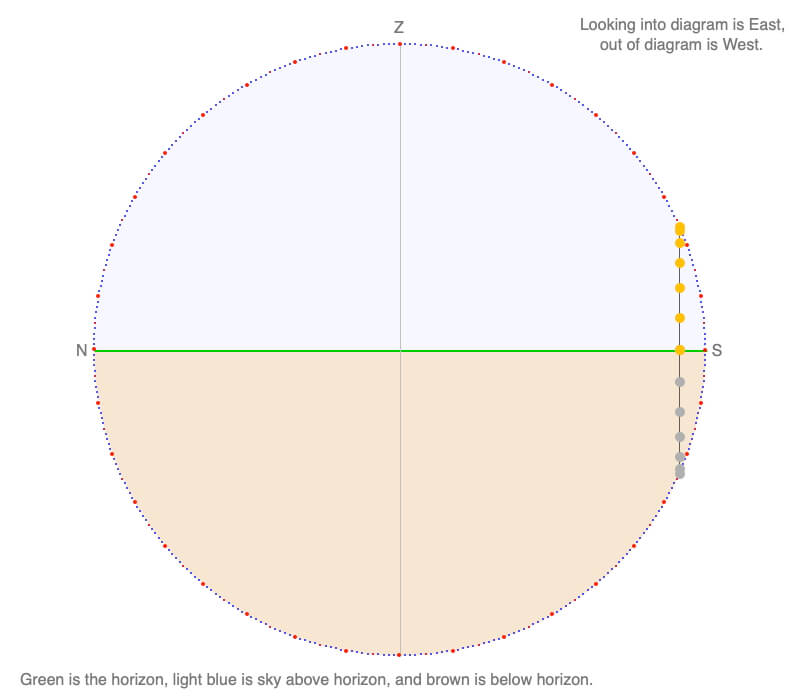
Ingredients for Large or Small Diurnal Temperature Change?
There are 12 hours of sunlight for heating and 12 hours of darkness for cooling, but the Sun doesn’t get above 23º above the horizon
Expect modest diurnal temperature change at this location for this day.
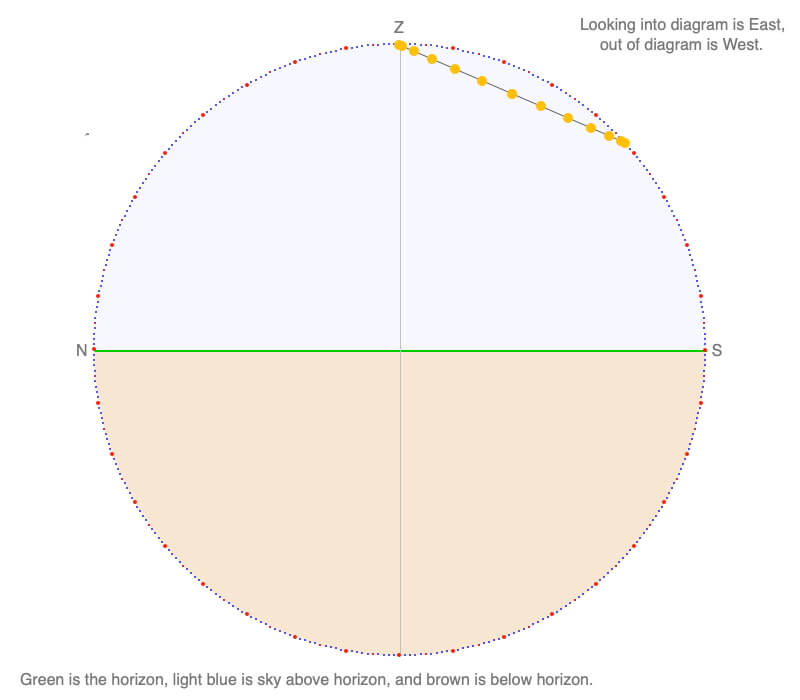
Ingredients for Large or Small Diurnal Temperature Change?
The Sun is above the horizon for the complete 24 hours, and there is quite a bit of heating! At local noon, the Sun is almost overhead, and it doesn’t go lower than 52º above the horizon. If the ground gets hot enough at local noon, then there may be cooling near local midnight, but it will most likely be modest.
This day and location have the ingredients for moderate diurnal temperature change, but it will be extremely hot this day.
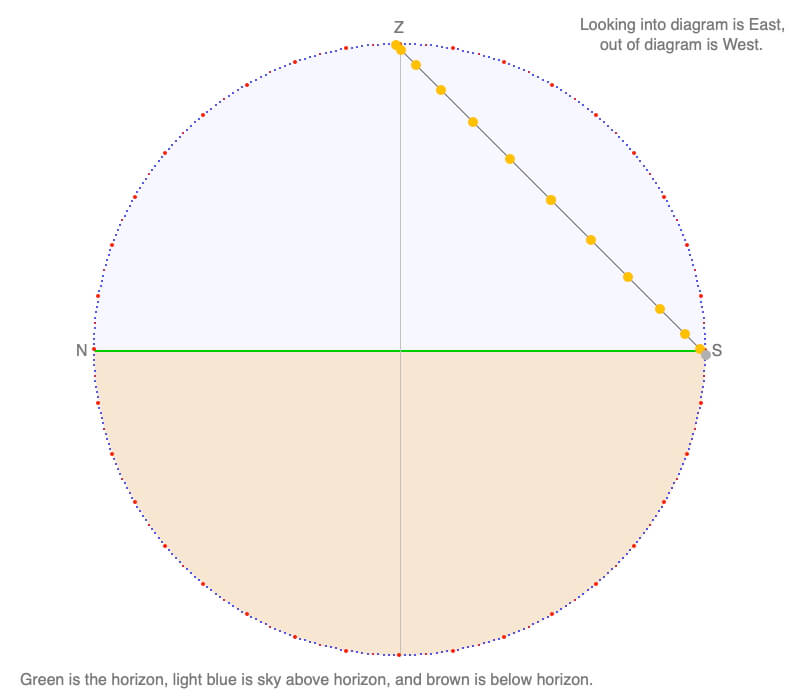
Ingredients for Large or Small Diurnal Temperature Change?
The Sun is above the horizon for the complete 24 hours, but the beam concentration changes dramatically throughout the day (goes from 1 to 0). The ground may heat considerably around local noon, and if it does, it will cool significantly by local midnight.
This day and location have the ingredients for substantial diurnal temperature change.
Big Ideas
- Two important factors determine how much an area will warm and cool throughout a day:
- The intensity of sunlight illuminating a unit area of ground and
- The duration of sunlight during the day.
- An area that experiences a lengthy period of darkness, 11 or more hours, yet a Sun high in the sky by local noon tends to have more substantial diurnal temperature change.
Click on the following toggles to view descriptions and links of the web pages on each topic of the Sun-Earth Connection.
Sun-Earth Connection overview
An overview of how the Sun’s energy is generated and how its thermal radiation illuminates and heats Earth.
Earth Illumination Patterns
- Overview: The Sun illuminates the spherical, rotating planets orbiting it.
- Obliquity and Earth’s Illumination: Obliquity is the angle between the planes of the Earth’s equator and its orbit around the Sun.
- Declination, Latitude, & Earth Illumination: Solar declination is the angle between the Sun’s rays and the plane of the Earth’s Equator. Its value depends on where Earth is in its orbit around the Sun.
- Astronomical Seasons & Illumination: Astronomical seasons are based on the orientation of Earth’s axis of rotation to the Sun, which determines the amount of illumination between the Northern and Southern Hemispheres.
Distribution of the Sun's Energy on Earth
- Overview: Even though an area is illuminated by sunlight, there can be quite a range of energy interacting with the surface.
- Sun Angle and Beam Concentration: If every beam of sunlight reaching Earth has the same amount of energy, why do some areas warm up more than others?
- Diurnal Heating: Diurnal heating is the temperature change over 24 hours. When sunlight shines on the ground, it warms. Two critical factors that determine the amount of heating deal with the Sun’s illumination.
- Seasons: Earth experiences astronomical seasons due to its obliquity.
- Climate Regimes: Climate regimes are an extension of diurnal heating and seasons, but the time frame is now years.
Declination Circles: A tool to analyze the Sun's position in the sky.
- Overview: Drawings of declination circles contain the visual and numerical information to understand and predict the Sun’s motion across the sky.
- Declination Circles 101: Draw a declination circle with just a ruler and protractor/compass to quickly and accurately know the Sun’s position in the sky at any day and time of the year for any location on Earth.
- Drawing Declination Circles: Declination circles are quite easy to draw by hand.
- Interpreting Time on Declination Circles: Accurately estimate the time of day using the Sun’s location in the sky.
- Sunrise, Sunset, & Twilight: Calculate the timing and duration when the Sun is at or near the horizon.
- Solar Time, Angle, & Position: The sun’s angle and direction to the local horizon define the Sun’s position in the local sky. Explore how to use declination circles to calculate the Sun’s position at any solar time anywhere in the world on any day of the year.
- Changing Views of Declination Circles: Use the web app View Declination Circles to explore three common views of declination circles to identify their strengths, limitations, and applications. Then learn how to go from one view to another.
- Using Declination Circles: Humans have been using the apparent motion of the Sun as a compass, clock, and calendar for millennia.
- Using Sundials: Humans have been using the Sun’s position to navigate and tell the time, day, and season for millennia. Sundials create shadows that make it easier to do these tasks.

0 Comments